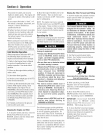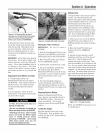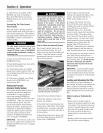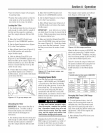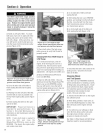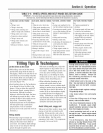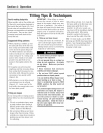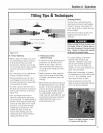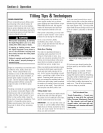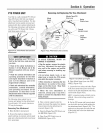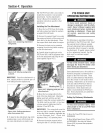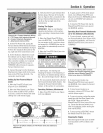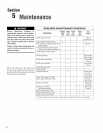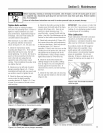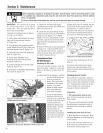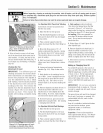
Section4: Operation
POWERCOMPOSTING
Powercomposting meanstiiiing under
and burying inthe soii ali mannerof
organic matter such ascrop residues,
leaves,grass ciippings and cover crops.
This materiaiwiii decomposeduring the
non-growing seasonand add important
naturai nutrients to the soil
When power ¢ompoating,donet keep
the Depth Regulator Lever at a deep
setting if the tiller jumpsor bucks.
tf jumping or backing occurs, move
the Depth Regulator Lever down to
one of the ehaJJowersettings and
then aJowJyincrease the tilling depth
on Jaterpasses.
Failure to complycouldresult in Joss
of tiJJer ¢entreJ,property damage or
personaJinjury.
Begin bycomposting crop residues such
as ieftovervines, staiks,stems and
roots. Powercompost these crop
residuesas soon asthey finish bearing.
The soonerthis is done,the better,as
tender green matter is easierto tiii
under. Usethe deepestdepth regulator
setting possible without causing the
engineto iabor or thetiller to jump
ahead.
Standingcornstaiks of reasonabieheight
canbe power composted (Figure4-20).
Pushing over (but not uprooting) corn-
stalks wiii often makeit easierfor your
tiiier to chop up the staiks. Keepthe
tines ciear of excessivetangling by "fish-
tailing" or frequentIy using reverse.
Makesevera!passes,then return a few
days iaterto finish off any remaining
stubble.
iq
After tiffing undercrop residues,add
more organic matter such as ieaves,
grass clippings and evenkitchenscraps.
Whentiiied into the soil, this organic
matter wili decomposeand add even
more important nutrients to the soft.
After power composting, you may want
to plant a "green manure" cover crop to
protect the softduring the off-season.
Growa crop of ciover, aifaifa,
buckwheat,peas, beans,ryegrass,
grain, or kaleandthen tiff it into the soil
prior to the pianting season.
Wide-Row Planting
The wide-row planting technique is
spreadingseedsanywhere from 10
inchesto 2 feet wide or more=Asa
resuit,you cangrow anywherefrom 3 to
4 times (or more) produce in the same
spacethat is normaliy set asidefor an
areathat hasnarrow, single rows.
Wide-row planting automaticallysilades
the ground which keepsweedgrowth
down and atso hoids moisture in the
soii. And of course,harvesting is much
easier- everything is rigllt at handto be
picked. Preparingwide rows is easy--
after you preparethe seedbedand mark
off the rows with string, hand-broadcast
the seeds asif seeding a lawn (not quite
as much as iawnseed). Coverwith soil
andtamp the areafirmty with a hoe.
Tilling Under Corn
After corn is harvested,the stalks shoutd
betiffed into the softwhiie stiii green.
Dry piants are moredifficult to tiii under,
andthe roots breakioosetoo easiiy=
iMPORTANT: Do not puii the roots out
by hand or cut the staiks before tilling.
Staiks that are firmly anchored by their
roots are much easier for the tines to
chop, cut, and work under=
ue$
1, As you moveforward into a row of
stalks,aim the tiller sothat the stalks go
betweenthe ieft wheei andthe transmis-
sion case (Figure4-19). Donot usethe
right wheel becausedamagecould occur
to the air cleaner,carburetor or throttie
linkage.
Figure 4=20: Tilting under corn
stalks.
2. Eachnew passshoutd overlapthe
previous pass by one-halfthe width of
the tinct=
3. Tiii asdeepiyas possible= Puii the
Depth Regulatorali the way UPand
engagethe lowest notch for deeptiiiing.
Useeither LOWor HIGHbait rangeand
SLOWwheelspeedgear position.
Letthe tiiied-in stalks decomposefor a
weekor so. Thentiii in the remaining
residueas deepaspossible=
$OHEnrichment idea
Trench Compesting _ Trench cem,
posting is easy with the eptionai
HiJJer.Furrawer Attachment (Section
5). Dig a trench, potin aJl kinds of
organic matter, and cover with soil
Earthworms and microbeswig breakit
downqoickJy.
24



